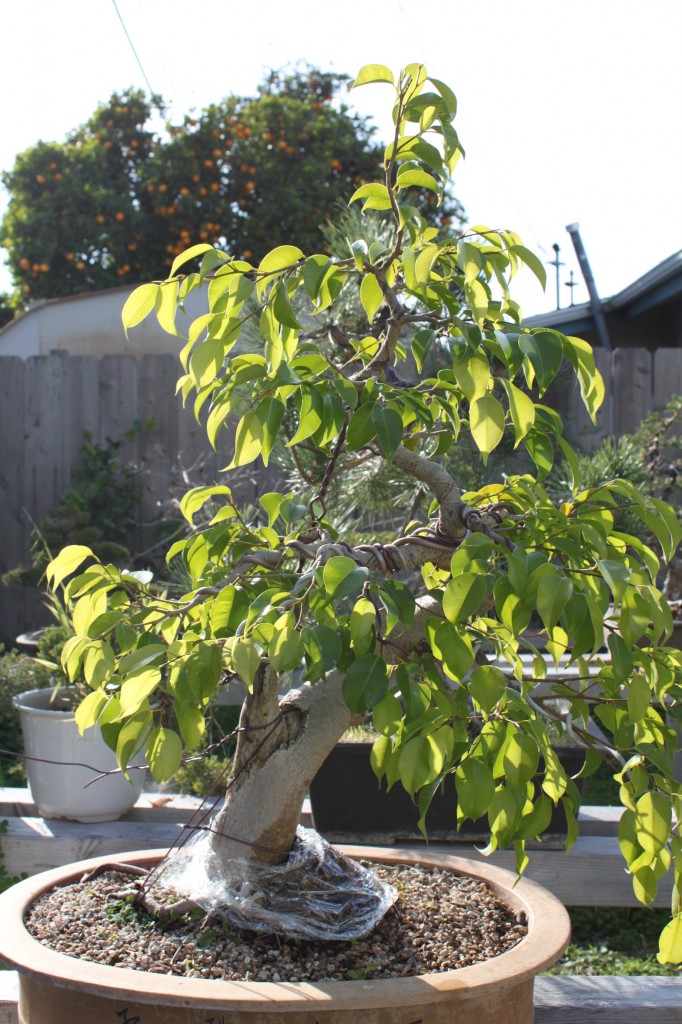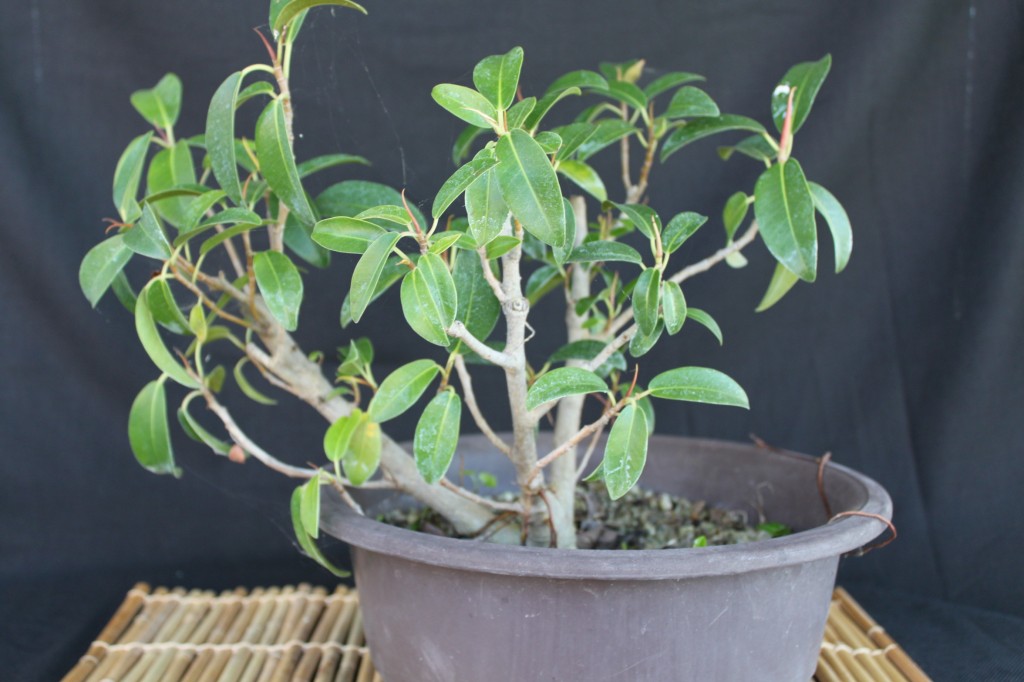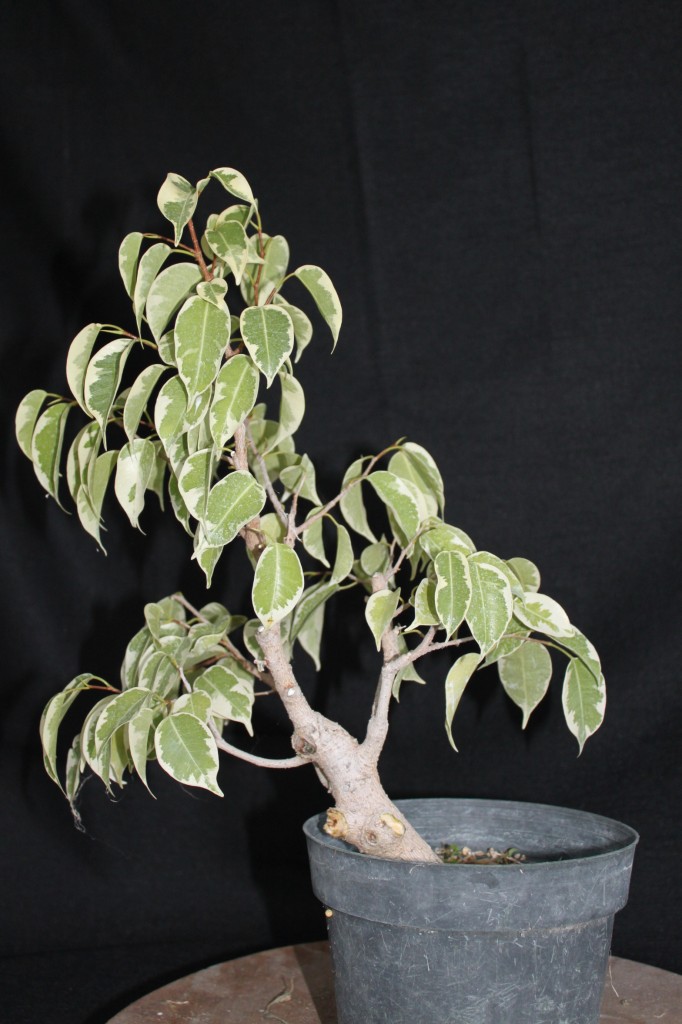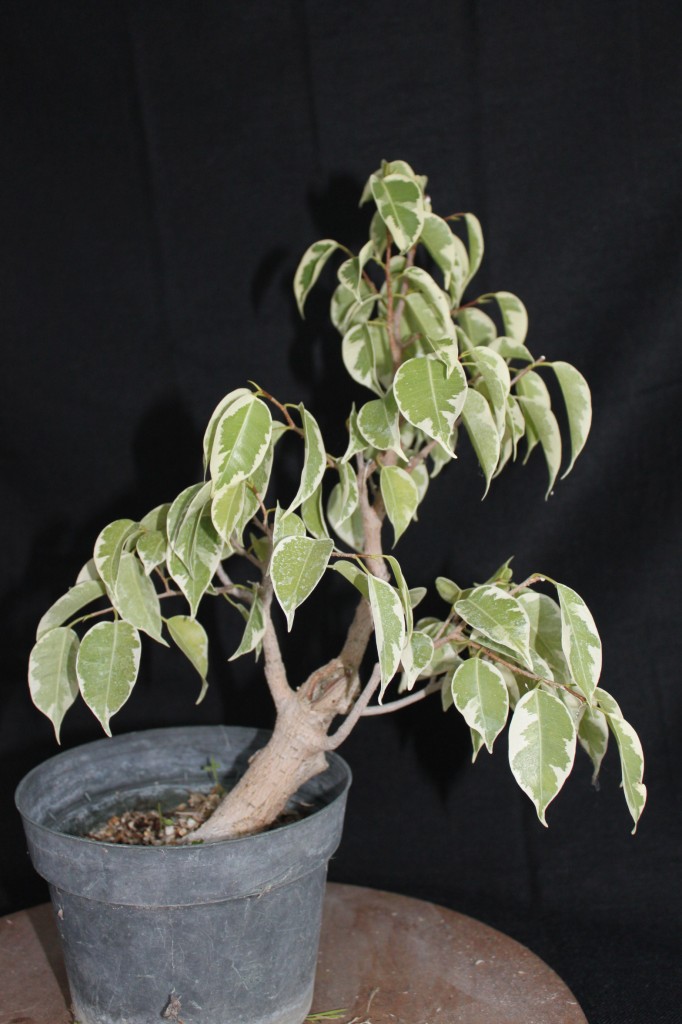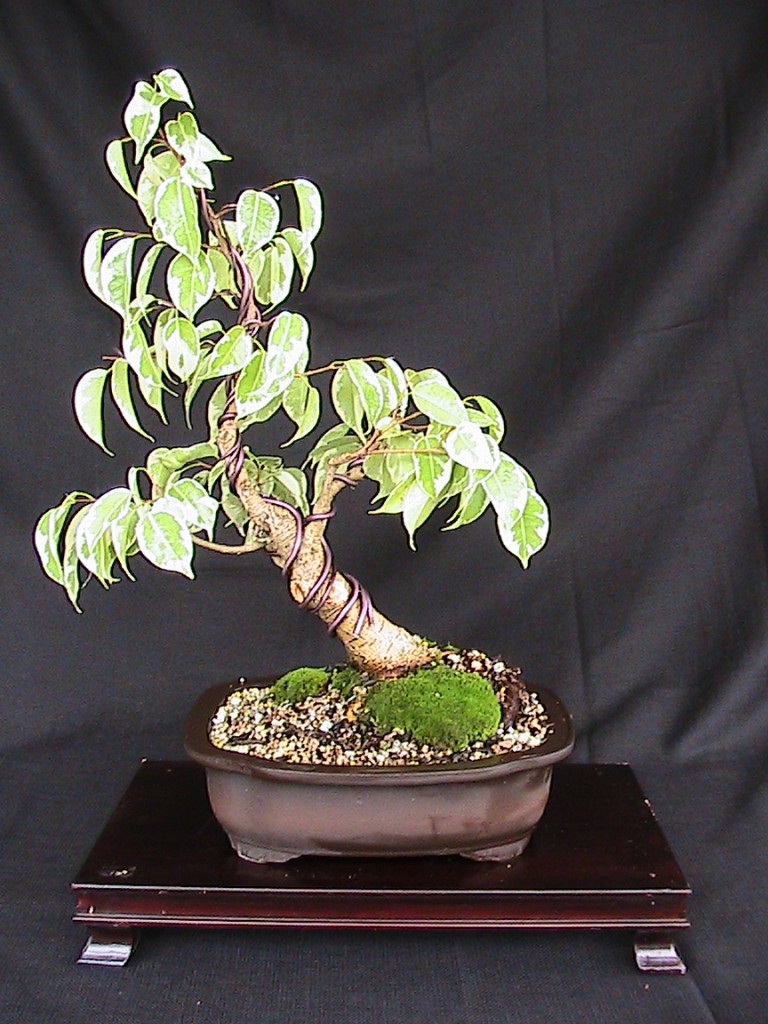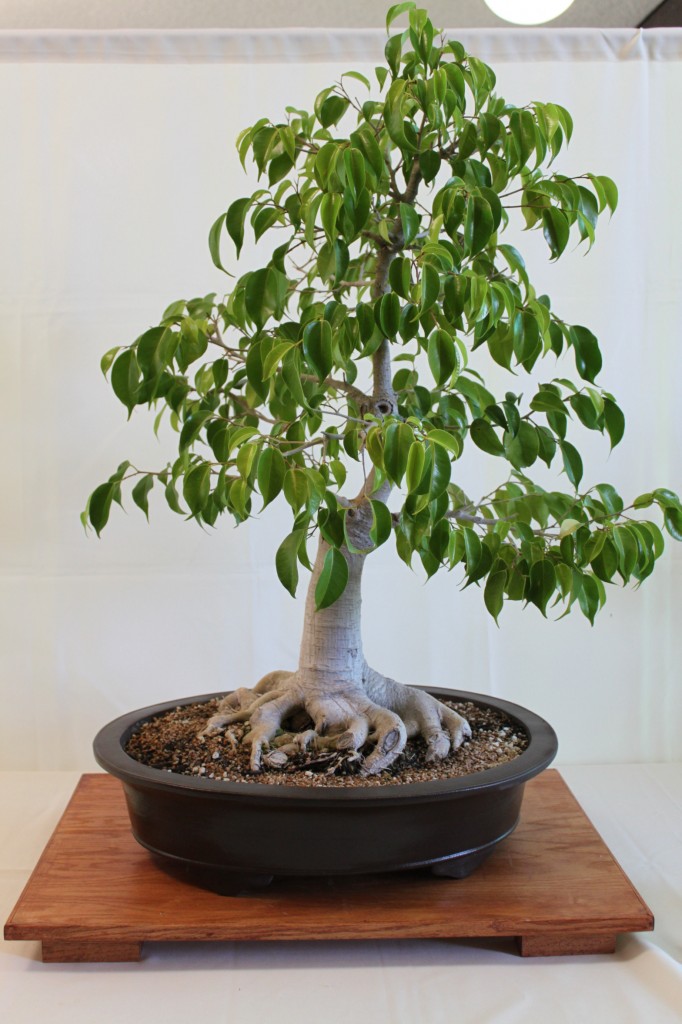Ficus Bonsai
Ficus Bonsai
Ficus, or Fig trees, are one of the commonest tropical trees. In some parts of the world, they dominate the landscape, and they are even considered pests. For example, in California, some folks use the Benjamin Ficus (Ficus Benjamina) as a landscape tree, since it is tolerant of cold weather once it is established. However, Ficus Benjamina has very invasive roots, and can easily send roots through foundations and into drainpipes. In Florida, Ficus trees have been known to take over entire yards by fueling horizontal branch growth with aerial roots. However, in miniature, as bonsai, Ficus trees can be absolutely fascinating, and Ficus bonsai never fail to captivate.
Background:
Genus Ficus consists of about 800 species of tree, which are found throughout the tropical regions of the world. Although Ficus trees are often seen in the background of films involving dinosaurs, most modern varieties of Ficus are likely to have originated thirty to forty million years ago, long after the dinosaurs vanished. There is one temperate species of Ficus, Ficus Carica (edible Fig or Common Fig). Ficus Carica is native to North Africa and Southern Europe. Like the Chinese Elm, Ficus Carica has established itself as a transplanted native in other areas with a Mediterranean Climate, such as Southern California. Some tropical varieties, such as Ficus Elastica, have commercial value. Their sap is used to make rubber.
There are about a dozen varieties of Fig that are commonly used for bonsai. These include Ficus Carica, (the edible fig), Ficus Benjamina, (Benjamin Tree), Ficus Religiosa, (the Sacred Fig or Bo Tree), Ficus Retusa (often called Ginseng Ficus), Ficus Aurea (Florida Strangler Fig), Ficus Microcarpa (Indian Laurel or Chinese Banyan) Ficus Macrophylla (Moreton Bay Fig), Ficus Rubiginosa (Port Jackson Fig), and Ficus Benghalensis (Banyan Tree).
Where to Get One:
Ficus trees are sold as nursery plants for landscape at plant nurseries in just about all tropical and subtropical parts of the world, and they are sold as houseplants in the more temperate parts of the world. Ficus bonsai can be purchased online from just about any online bonsai seller, and shipped just about anywhere in the world that does not have restrictions on importation of non-native plants. It is also possible to collect specimens with large trunks from landscapes, or even from the wild in places where the ficus is considered to be a non-native pest. Be careful when buying a Ficus bonsai from an online retailer. These trees are often mass produced in China, and rocks are glued on top of the soil in order to hold moisture in the pot and prevent the soil from being disturbed during shipping.
If you want to grow your own, don’t try it from seeds or fruit. Ficus trees have a unique symbiotic relationship with an insect called the Ficus Wasp, and can only be pollinated by this wasp. The ficus flowers form inside the fruit, and only the wasp can enter the fruit to pollinate the flower. If you do not have Ficus wasps, then you will not have Ficus seeds.
Fortunately, there is no need to sit around and wait for a wasp to crawl into your figs if you want more Ficus trees. Ficus trees reproduce from cuttings so easily that it is usually a matter of just taking the cutting, sticking it into some soil, watering it and waiting a week or two for it to sprout new growth. The thick, milky sap common to all ficus trees means that there is no need for rooting hormone. One caveat: If you do not live in a tropical area, you should only take ficus cuttings during the active growing season, and the warmer the weather is, the better.
What To Do With It After You Get It:
If you bought one online, remove the glued on rocks from on top of the soil. While old hands may chuckle at this, if you are a beginner, this is really the first thing you should do. Online sellers glue the rocks on to keep the soil in the pot during shipping, and hold the moisture in the soil during shipping. Once you have the tree it serves no useful purpose and can harm the tree by impeding soil aeration.
If you purchased a prebonsai, or raw material, then the question is: How big do you want it? Ficus trees, aside from specialized cultivars such as Ficus Benjamina “Natasha,” tend to grow very fast. If your ficus is not big enough, put it in a large tub, give it plenty of water, fertilizer and a modicum of sunlight, and wait a while. Or put it in the ground, but don’t leave it there for long, unless you want your neighbor to take you to court when the roots reach his plumbing – or undermine his gazebo.
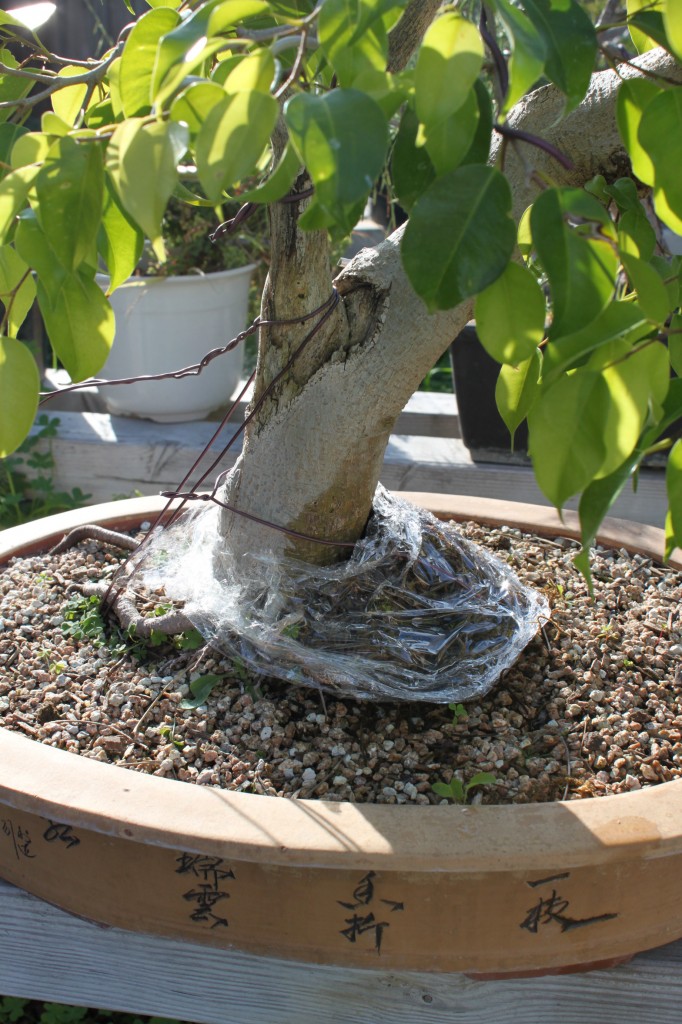
A Ficus Benjamina grown from a thick cutting. The cutting was the entire lower trunk you see in the photo. The sphagnum moss at the base is to induce more roots and a better root flare.
Soil and Potting:
Once you have your Ficus bonsai, you must consider soil and potting. Even if you purchase an already styled bonsai it will eventually need to be repotted. As bonsai, Ficus like free draining soil, but with a fair amount of organic matter – you can go as high as 50%. Aggregate for drainage can be coarse sand, pumice, decomposed granite, high fired clay pellets or diatomite. The preferred organic matter is composted tree bark.
Ficus trees can be repotted during just about any part of the growing season, but they must be repotted in warm weather. Most varieties of Ficus tolerate root pruning fairly well, but be careful. Root pruning, especially severe root pruning, in weather that is not warm enough can kill the tree.
Siting:
In most places a Ficus bonsai can be kept indoors, provided that it receives enough sunlight. If you have an indoor location for your Ficus Bonsai that does not receive sufficient light, then you will have to supplant the natural light or interior light with a grow light. Ficus trees grown in insufficient light generally will drop their leaves, or they will lose lower leaves and produce very large upper leaves in their quest for more light. In warmer climates, Ficus bonsai are best kept outdoors, where they will receive plenty of sun and fresh air. Just about all varieties of Ficus can withstand direct sunlight, and seem to benefit from it, but watch them carefully during hot weather. They will draw a lot of water from the soil, and in a small bonsai pot they will dry out their soil very quickly. Although they need good drainage as much as any other bonsai, Ficus trees do not like dry soil, and they always like to have some moisture in the soil.
Pruning and Shaping:
Because they are very fast growing, ficus trees are best shaped by pruning. Shaping Ficus bonsai with wire is problematic. You can wire thinner growth on Ficus bonsai, but wire loosely and be prepared to unwire fast. Ficus trees grow rapidly, and you may have to rewire a Ficus bonsai as many as five times during a single growing season. In addition, the wood of some varieties of Ficus, such as Benjamina, is very springy and will not take a set until it gets relatively thick. You may have to wire ten or fifteen times over a two or three year period in order to place a Benjamina branch where you want it. Even a Banjamina branch half an inch thick can still bend very easily – and start growing upward after spending two years wired into position. When pruning a Ficus you can remove most, but not all of the foliage. Most varieties of Ficus respond well to a trunk chop. Be careful when pruning branches back to bare wood. Some varieties of Ficus, such as Carica and Benjamina, do not bud back well. With Benjamina trees, you should leave a small amount of greenery on the tree above the point where you want back budding to occur. This will allow the tree to draw sap in order to form the new growth.
Most varieties of Ficus (Other than Ficus Carica) are capable of forming aerial roots. However, Ficus trees need warm, humid weather in order to stimulate aerial root growth. Enthusiasts in cooler climates provide this by using humidity trays and greenhouses or terrariums.
Styling:
If you purchase an already styled Ficus bonsai, you can skip this section. Ficus trees work well as just about any style of bonsai, from broom to the upright styles, to cascade, forest, and groups. They also have their own unique style based on the presence of aerial roots – banyan tree style. Before you style a ficus bonsai, you should study photos of large ficus trees in the wild in order to become familiar with their growth habit – or even take a trip to the tropics in order to view ficus trees in their native environment.
Ficus trees make beautiful bonsai, but only if properly cared for. Unlike most other varieties of bonsai, they can be kept indoors for long periods of time, where there is sufficient light. If you take proper care of your Ficus bonsai, it will provide you and your home with lasting beauty for years to come.

